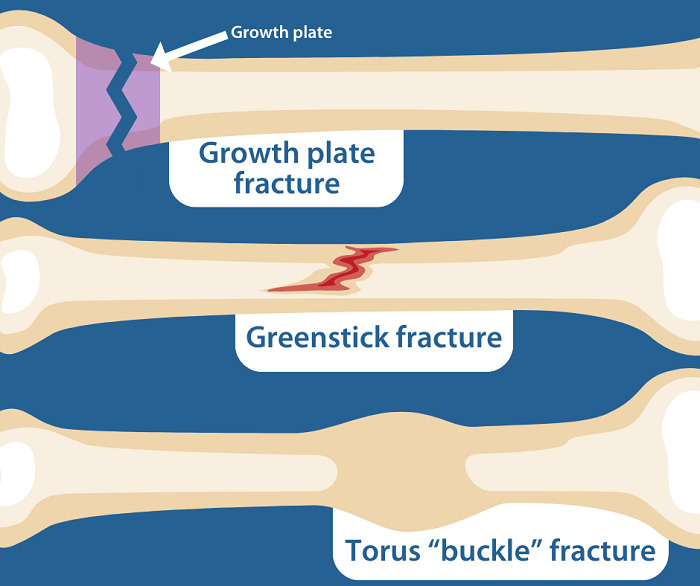
Special to Iredell County
Accidents happen, especially with little ones running around. Parents are often used to taking care of minor injuries like scraped knees or bruised elbows. However, every parent dreads the moment when fun at the playground ends with a broken bone.
Fractures are common in children, with about half of all children experiencing at least one broken bone. It’s a scary scenario for parents, but with the right knowledge, parents can ensure a smoother healing journey for their children.

“In young children, up to the time of puberty, most bones are not completely calcified and have a significant cartilage component to them. This makes kids’ bones ‘softer’ or bendable,” said Dr. Anthony Elkins, a physician at Iredell Primary Care.
Most fractures in children are considered incomplete fractures, such as torus fractures or greenstick fractures. In a torus fracture, the bone is buckled, twisted, and weakened but not completely broken. In a greenstick fracture, the bone bends and only breaks or splinters on one side like a green branch, which the fracture is named after. However, complete fractures, in which the bone breaks completely, may also occur in children.
Because your child’s bones are still growing, they are more vulnerable to growth plate fractures, also called salter-harris fractures, which do not occur in adults.
“Up to the age of 18, when long bones, such as the femur or humerus, are still actively growing, the shaft of the bone or ‘diaphysis’ may be calcified completely, but the growth plate or ‘epiphysis,’ which is the site of active growth, is still soft tissue,” said Elkins.
Since growth plates are not solid bone, growth plate fractures can be difficult to detect on an Xray. Symptoms may include minimal pain or swelling. However, it is important to treat these small fractures correctly since they may affect the future growth of the bone.
Fractures can occur in any bone of the body, but the bones kids are most likely to break are the:
• Distal forearm (part of the forearm closest to the wrist): Usually caused by a fall to the
outstretched hand, such as falling off a bike or skateboard;
• Fingers: Usually caused by crushing injuries, such as fingers getting closed in the door;
• Collar bone: Usually caused by a fall landing sideways on the shoulder, such as falling off a bike or being tackled in football;
• Ankle: Usually caused by an inversion of the ankle, such as your child’s ankle rolling when coming down from a jump;
• Toes: Usually caused by an object falling onto them
How do I know if my child has a fracture?
Symptoms of a fracture usually include pain, swelling, deformity, bruising, and loss of function. But it’s not always easy to tell if your child has a fracture, especially if they are too young to describe their feelings. However, if they avoid moving the injured site, a fracture is likely.
Most movies and TV shows depict a broken bone as a visual deformity; however, the majority fractures will not protrude through the skin. Most fractures will have pain, swelling, and bruising.
What should I do if my child breaks a bone?
According to Elkins, if your child has a broken bone, they will usually hold the injured area in a position of comfort, but you should not let them move or touch the area.
“Apply an ice pack to the area to reduce pain and swelling. It can be splinting by wrapping with an ACE bandage, towel, or clothing to protect it until seen by a doctor,” said Elkins.
If you believe your child has broken a bone, you should seek medical attention immediately.
“Correct and prompt diagnosis is essential to result in the best chance for proper healing and regaining function. This usually involves going to the emergency room, where X-rays are readily available. I recommend discussing the management of injuries with your primary doctor so that they can tell you the best approach that exists in your community. Some doctors recommend going directly to the ER, and some are trained in fracture care and can manage it personally,” said Elkins.
After examining the break, the doctor will order X-rays to determine the extent of the injury.
Depending on the location and severity of the fracture, plaster or fiberglass casts, splints, braces, or boots may be used.
“Casting a fracture consists of applying a soft cotton sleeve or gauze to protect the skin from friction and to relieve pressure over bony prominences. The outer layer of the cast is usually made of fiberglass material. The casting material is wet to allow it to be moldable. It is then wrapped around the injured area to hold it in the proper position. Within 20-30 minutes, the material hardens or sets,” said Elkins.
How can I care for my child’s cast at home?
If your child comes home with a cast, it’s important to know how to care for it properly so their healing journey is as smooth and quick as possible. Caring for your child’s cast involves more than just monitoring the injury. It involves understanding how to keep the cast clean, dry, and comfortable.
Most casts are meant to stay dry, as a wet cast can lead to skin irritation or infection and damage the cast material.
“Casts should not be allowed to get wet, so if a child is to take a shower, the cast will need to be wrapped in a plastic bag and sealed with duct tape or a rubber band to protect it. If a bath is taken, the cast will need to be kept away from the water. Swimming will not be allowed since casts cannot be submerged,” said Elkins.
Many children complain of itching under the cast, but it’s crucial not to put anything inside the cast to scratch. To lessen the itching, keep the area inside the cast as dry and cool as possible.
“Itching under a cast is common and frustrating since the itch cannot be easily reached. Objects should not be inserted inside a cast to reach the itch to avoid injuring the skin, since a wound or bleeding could require the cast to be removed to allow treatment of the wound,” said Elkins.
“Itching could be treated by using a hair dryer set to the cool setting and blown into the cast. Antihistamines such as Benadryl or Zyrtec may help.”
If you notice your child’s fingers turning red, blue or feeling numb, increasing redness or swelling around the cast site, or worsening pain from the fracture, your child’s cast may be on too tight. In this case, you should notify the doctor immediately, as the cast may need to be adjusted.
LEARN MORE
Dr. Elkins practices at Iredell Primary Care, located at 114 Gateway Boulevard in Mooresville. He has expertise in the musculoskeletal system and cares for patients of all ages. Patients can be seen within 24 to 48 hours. Same-day sick visits are also available for established patients. Head to IredellPrimaryCare.com or call 980-435-0406 to schedule you or your child’s next appointment with Dr. Elkins.
About Iredell Health System
Iredell Health System includes Iredell Memorial Hospital; Iredell Mooresville; two urgent care centers; Iredell Home Health; Iredell Wound Care & Hyperbaric Center; Community and Corporate Wellness; Occupational Medicine; the Iredell Physician Network and more. Iredell Memorial Hospital is the largest and only nonprofit hospital in Iredell County. The comprehensive healthcare facility has 247 beds; more than 1,800 employees; and has 260 physicians representing various specialties. Centers of excellence include Women’s and Children’s; Cardiovascular; Cancer; Surgical Services and Wellness & Prevention. The Health System’s second campus, Iredell Mooresville, is home to the area’s only 24-hour urgent care facility, as well as an ambulatory surgery center, imaging center, rehabilitation services, and physician practices. The mission of Iredell Health System is to inspire wellbeing. For a comprehensive list of services and programs, visit www.iredellhealth.org.



